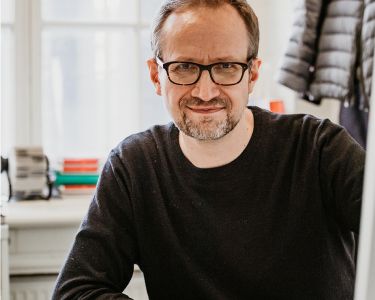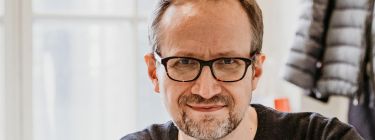
Arts Education for All: The Case of Finland
Managing Director at KAAPELI cultural centre, Helsinki
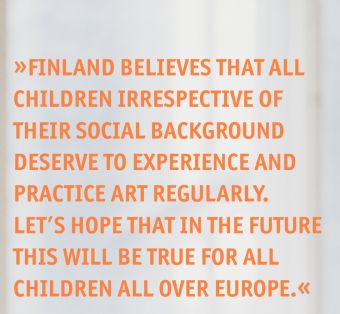
Arts Education for All: The Case of Finland
Cultural capital supports the capacities of children and young people to actively participate in society. Experiences from Finland show, however, that a generous public service provision doesn’t necessarily mean equal service offering for all. Children with a minority background and children coming from lower social classes are underrepresented among the users of the cultural programs aimed for children and young people. Recent initiatives in Helsinki, the Finnish capital, may have found a new way to tackle this challenge.
A national program for Arts education
Finland was named the happiest country in the world in 2021 by the UN Sustainable Development Solutions Network for the fourth time in a row. Alongside with the other Nordic welfare states, the country is well-known for its generous public services. These services include the public school system as well as the public healthcare system, but Finland invests heavily also in children’s arts education. And for good reason: arts and culture are known to have a positive impact on children and on young people and their future.
The national program called Basic education in the arts provides after-school-hours arts education in the local art schools in Finland. Training is goal-oriented, tied to a national curriculum and taught by professionals in the field. There are nine different art forms to choose from: architecture, circus, crafts, dance, media, music, literary art, theatre and visual arts (Luoma, 2020). Typically, education is subsidised both by the national and the local government. However, as the services are provided by private organisations, participants are required to pay to fee in order to participate.
Although, this model has resulted in admirable results—especially in the field of classical music that can be monitored both in the numbers of people playing classical music themselves and in the popularity of classical music concerts—the system hasn’t been as successful in reaching all demographic groups of the Finnish society. A study conducted by the City of Helsinki in 2016 showed that the proportion of students attending the program was much higher in wealthier social classes than in the lower ones.
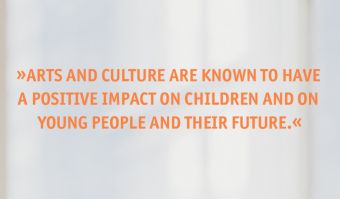
Socially disadvantaged children cannot be reached
When dividing Helsinki’s neighbourhoods in three groups according to their socio-demographic profiles, it could be concluded that participation in the arts program was most frequent where the socio-demographic profile was highest, where the services were easiest to reach and where the educational offering was highest. Participation was the lowest in the lowest socio-demographic profile and where the distance to the training places where the longest. An additional finding was that a large portion of the participants in the educational program were children and youth that had already multiple other hobbies (Vismanen et al., 2016).
Another study looking at the cultural policy and cultural diversity in the Nordic countries revealed that “people belonging to minorities, immigrants, and natives with a foreign background are mostly underrepresented both as artists, as people employed by arts institutions and organisations, and as public or audience” (Saukkonen, 2018). In addition, the challenge to reach these underrepresented groups had become more complex over time as the number of minorities had and diversified ethnically, linguistically and religiously.
Academic research and experiments
In attempting to find solutions to the situation, Finns have relied on one hand on academic research and on the other on experimentation with new ideas.
In 2016, The University of the Arts Helsinki started a six-year project called ArtsEqual. It was the largest research initiative in the field of arts ever to have taken place in Finland studying arts as public service and aiming for better equality and resulting in policy recommendations. All in all, six research groups studied the subject from various sides. The group “Basic Arts Education for All” emphasised in one of its policy briefs (Laes et al., 2018) that although arts and cultural education strengthen the cultural capital of children and young people and support their capacities to actively participate in the society, the unequal access to them could also increase the social exclusion of the children that could not participate in the program for some reason. In turn, a policy recommendation (Anttila et al. 2017) by the research group “Arts@School” suggested that public schools should be seen as “Finland’s largest cultural centres, where high-quality, diverse arts and cultural education is equally available to all.”
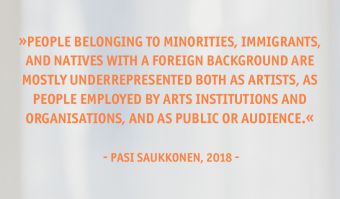
In parallel to this research work, the City of Helsinki launched a pilot phase of the Helsinki Model of arts education that brought the activities to suburbs and, thus, closer to the disadvantaged groups. Also, an arts education project called “Art Testers”, led by the Association of Finnish Children’s Cultural Centres was launched targeting teenagers.
The pilot phase of the Helsinki Model that lasted three years (2016-18), consisted of four case studies in four different suburbs around Helsinki (Lindholm & Päiviö-Häkämies, 2020). It relied on the cooperation of the cultural department of the City of Helsinki, of neighbourhood associations and of cultural institution ranging from theatres to museums and to dance and circus companies. The pilot succeeded in improving the perceived quality of life in the pilot suburbs but it taught that the local population couldn’t be reached simply by delocalising the old model of arts education. The content needed to be adapted to the setting. And yet, the most challenging groups—socially most marginalised and minorities not speaking Finnish—were still very hard to reach. This was partly because they didn’t have any previous relation to art or had even a hostile attitude toward it. City of Helsinki continues the Helsinki Model program and keeps fine-tuning it.
Art Testers integrated cultural offerings to the school curriculum initially from 2017 till 2020. Every year, it brought all Finnish 8th graders (15-year-olds) to a visit in one or two high-esteemed art attractions across Finland, such as opera or theatre performance, a concert, or an arts exhibition (Art Tester, 2021). School groups were provided with tickets and transportation to the events. Approximately 60,000 teenagers participated in the project yearly. The project ended up being so popular and successful that in the fall 2020 the Finnish Ministry of Education and Culture secured the continuation of the program.
Towards the future with “Hobi” and “Culture Kids”
Based on the research results of ArtsEqual and on the experiences gained from Helsinki Model and Art Testers, Finland is now complementing its Basic education in the arts with Hobi, the Finnish model for leisure activities (https://harrastamisensuomenmalli.fi/en/). In parallel, a new project called “Culture Kids” is being launched in Helsinki. Both initiatives aim to make their offering as accessible as possible so that truly every child could take part in the activities equally. However, the age groups targeted in each project are different.
The main objective of Hobi is to increase the wellbeing of school children by providing them a leisure activity free of charge through the school system (Hobi, 2021). However, the model is not restricted only to art-related leisure activities, and sports activities, for example, are included as well. The activities are funded by the ministry and organised by professional actors in the field of leisure in cooperation with schools. Hobi’s website started operating in August 2021.
Culture Kids’ target group, in turn, is babies, as well as their families (Culture Kids, 2021). For every child born in 2020 or after and living in Helsinki the project will designate a cultural operator that will sponsor the child’s initiation to art. The cultural sponsor is determined by the year of birth of the child. Children born in 2020 are sponsored by the Helsinki Philharmonic Orchestra, and children born in 2021 will be sponsored by theatres in Helsinki. Every year, the sponsor will invite the child and his/her family to at least two cultural events that are designed to support the child’s developmental stages and promote the well-being of their family. Culture Kids events are free of charge and the activities will continue until the child starts school. By inviting the whole age group with their family members, the program hopes to attract families that wouldn’t otherwise be prone to participate in cultural activities and by maintaining the sponsorship for six years, it aims for a lasting and living relationship between the children and art.
The Finnish example shows that even successful arts education programs have flaws and that if an arts education program has social aims, its practices need to be regularly revisited, as the demographics of our societies change. Finland believes that all children irrespective of their social background deserve to experience and practice art regularly. Let’s hope that in the future this will be true for all children all over Europe.
References
Anttila, Eeva et al. Peruskoulu: Suomen suurin kulttuurikeskus, (2017), ArtsEqual Policy recommendation 2/2017
Art Testers website (2021), https://taidetestaajat.fi/en
Culture Kids website (2021), https://kummilapset.hel.fi/brochures/en.pdf
Happiness Report 2021 (2021), https://happiness-report.s3.amazonaws.com/2021/WHR+21.pdf
Hobi – The Finnish Model for Leisure activities website (2021)
Laes, Tuulikki et al. Toimenpidesuositus Saavutettavuus ja esteettömyys taiteen perusopetuksen lähtökohtana (2018), ArtsEqual Policy recommendation 1/2018
Lindholm, Arto & Päiviö-Häkämies Laura (ed.). Helsingin malli – taidetta ja osallisuutta lähiöihin Miten pilottikauden hankkeet tavoittivat alueiden asukkaat 2016–2019?, (2020), Humanistinen ammattikorkeakoulu julkaisuja, 114.
Luoma, Tiia, TAITEEN PERUSOPETUS 2020 – Selvitys taiteen perusopetuksen järjestämisestä lukuvuonna 2019–2020, (2020), Opetushallitus, Raportit ja selvitykset 2020:4
Saukkonen, Pasi, Cultural policy and cultural diversity in the Nordic countries (2018), https://pasisaukkonen.wordpress.com/category/kulttuuripolitiikka/
Vismanen, Elina; Räsänen, Petteri, & Sariola Reetta, Taiteen perusopetuksen tila ja kehittämistarpeet Helsingissä (2016), Helsingin kulttuurikeskus
Dr. Kai Huotari
Managing Director at KAAPELI cultural centre, Helsinki
Dr. Kai Huotari (b. 1972) has 20 years of management experience in the fields of culture, academia and technology. Since 2015, Huotari has worked as Managing Director at KAAPELI the largest cultural centre in Finland. Huotari has held managerial positions also at EIT Digital, at Helsinki Institute for Information Technology HIIT, and at DocPoint – Helsinki Documentary Film Festival. In 2010-2012, Huotari worked as visiting scholar at UC Berkeley School of Information. He is a member of the board of YLE The Finnish Broadcasting Company and he serves as chairman of the board in Kunsthalle Helsinki. Huotari has a doctoral degree in economics and business administration, an M.A. degree in filmmaking, and a M.Sc. degree in computer science.
Picture © Mr. Vertti Luoma
